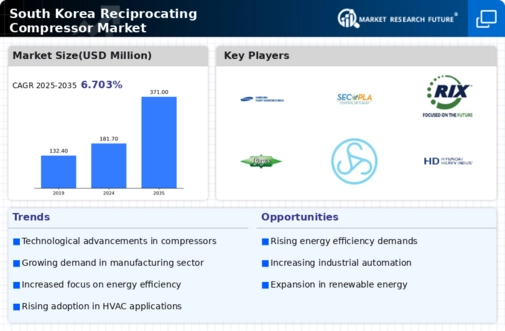Expansion of Oil and Gas Sector
The oil and gas sector in South Korea is undergoing expansion, which could have a positive influence on the reciprocating compressor market. With the increasing exploration and production activities, there is a heightened need for reliable compression solutions. The sector is projected to grow at a CAGR of 5% over the next five years, indicating a robust demand for compressors that can handle high pressures and varying gas compositions. Reciprocating compressors are particularly suited for these applications due to their versatility and efficiency. As the oil and gas industry continues to evolve, the reciprocating compressor market is expected to capitalize on this growth opportunity.
Rising Demand in Manufacturing Sector
The manufacturing sector in South Korea is experiencing robust growth, which appears to be driving the demand for the reciprocating compressor market. As industries such as automotive, electronics, and machinery expand, the need for efficient and reliable compressors becomes increasingly critical. In 2025, the manufacturing output is projected to reach approximately $500 billion, indicating a potential increase in compressor usage. This growth is likely to be fueled by the need for compressed air systems in production processes, thereby enhancing the overall efficiency of operations. The reciprocating compressor market is expected to benefit from this trend, as these compressors are known for their reliability and performance in high-demand environments.
Regulatory Support for Industrial Growth
Regulatory support from the South Korean government is fostering growth in the industrial sector, which in turn is benefiting the reciprocating compressor market. Policies aimed at promoting industrialization and technological advancement are encouraging companies to upgrade their equipment, including compressors. The government has set ambitious targets for industrial output, which could lead to an increase in the demand for reliable and efficient compressors. As industries strive to meet these targets, the reciprocating compressor market is expected to see a rise in adoption rates, particularly in sectors such as manufacturing and energy.
Increased Investment in Energy Efficiency
There is a growing emphasis on energy efficiency within South Korea, which may significantly impact the reciprocating compressor market. The government has introduced various initiatives aimed at reducing energy consumption across industries. As a result, companies are increasingly investing in energy-efficient technologies, including advanced reciprocating compressors. These compressors are designed to operate with lower energy consumption, potentially reducing operational costs by up to 30%. This shift towards energy efficiency not only aligns with national goals but also enhances the competitiveness of businesses in the market. The reciprocating compressor market is likely to see a surge in demand as industries seek to comply with these energy regulations.
Technological Innovations in Compressor Design
Technological innovations in compressor design are playing a pivotal role in shaping the reciprocating compressor market. Recent advancements have led to the development of compressors that offer improved performance, reduced noise levels, and enhanced durability. These innovations are particularly appealing to industries that require high reliability and efficiency. For instance, the introduction of variable speed drives allows for better control of compressor operation, potentially leading to energy savings of up to 20%. As industries in South Korea adopt these advanced technologies, the reciprocating compressor market is likely to experience increased demand, driven by the need for modern and efficient solutions.

















Leave a Comment